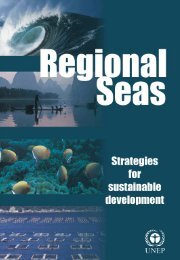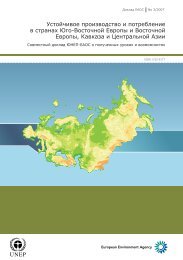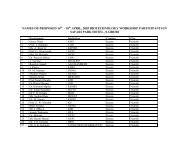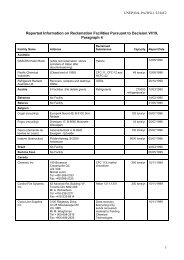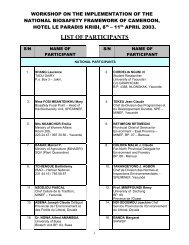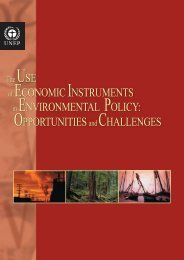Best Practices for Organic Policy - What developing country - UNEP
Best Practices for Organic Policy - What developing country - UNEP
Best Practices for Organic Policy - What developing country - UNEP
You also want an ePaper? Increase the reach of your titles
YUMPU automatically turns print PDFs into web optimized ePapers that Google loves.
<strong>Best</strong> <strong>Practices</strong> <strong>for</strong> <strong>Organic</strong> <strong>Policy</strong><br />
• Nationwide professional promotion.<br />
A common mark (label) that is actively promoted has much more impact than a common standard or a<br />
government regulation (but they can obviously be mutually supportive), as most consumers can easily<br />
recognize a mark, while they normally have little knowledge or even little interest in the standards and<br />
regulations. Such an organic mark can have many <strong>for</strong>ms. It can be a governmental label accessible <strong>for</strong><br />
producers certified by an approved body (USDA, JAS or Denmark), it can be a mark of the organic<br />
association available <strong>for</strong> its members, it can be a mark owned by the trade, or it can be the mark of a<br />
certification body (e.g. BioSuisse or Demeter). In Denmark, 92 per cent of consumers recognize the<br />
governmental label <strong>for</strong> organic products; in Sweden, 96 per cent of consumers recognize the private<br />
KRAV mark (KRAV 2005). Initially, the ownership or the underlying construction around a mark is<br />
not very important. More important is that it is widely used on all organic products. There<strong>for</strong>e, an<br />
accessible “marketing mark” is likely to be most successful 43 . By public ownership or collective<br />
ownership (e.g. by an organic sector business association or organization), the future policies <strong>for</strong> its<br />
use can be adapted to the various stages of development.<br />
In Europe, some countries have applied a push strategy <strong>for</strong> the expansion of the organic markets, and<br />
others a pull strategy. A push strategy focuses on measures to enlarge production, assuming that once<br />
there is more supply, market demand will be created. The pull strategy has market demand as the<br />
driving <strong>for</strong>ce. The push strategy is based on generous payments to organic farms, something that is<br />
out of reach <strong>for</strong> most <strong>developing</strong> countries. Also, the push strategy has the potential to seriously harm<br />
a small and volatile organic market, at least in the short term. On the other hand, too <strong>for</strong>ceful ef<strong>for</strong>ts in<br />
marketing can fail if there are no products to sell. A combination of market supply and demand<br />
measures is more promising (Hamm, Groenfeld and Halpin 2002). From East Africa (Taylor 2007),<br />
Thailand, Costa Rica and Malaysia, lack of supply is mentioned as a factor limiting domestic market<br />
development. It is apparent that policies seeking to influence the market need careful design and<br />
adaptation.<br />
Pricing of organic products is, as shown above, a relevant factor. Also in <strong>developing</strong> countries,<br />
sometimes very high premium prices are quoted <strong>for</strong> organic products, often up to double the price<br />
compared to conventional, and in the case of Malaysia up to 400 per cent – much higher than the<br />
premiums in OECD markets. On the other hand, there are also a number of examples where there is<br />
no particular premium charged <strong>for</strong> organic products (Rundgren 2007). To a large extent, the premium<br />
prices in organic are a result of inefficient distribution of small quantities rather than high farm-gate<br />
prices. Most important <strong>for</strong> a decent pricing level is probably to organize the supply and the<br />
distribution, which requires collaboration by the actors. With growing volumes, distribution can be<br />
more efficient and retail prices are likely to go down, not necessarily putting pressure on farm-gate<br />
prices. Distributing organic products through mainstream channels such as supermarkets will help in<br />
this, but supermarkets are also very demanding clients and an emerging organic sector may not be<br />
able to fulfil their stringent quality and just-in-time delivery demands. The need <strong>for</strong> better market<br />
in<strong>for</strong>mation is highlighted in several of the case studies.<br />
Supply chain management and processing<br />
Producer organizations are often under-resourced and the lack of proper distribution infrastructure can<br />
be fatal both <strong>for</strong> export and local markets. This is not particular <strong>for</strong> organic, but as a “new” sector, one<br />
can assume that there will be more obstacles <strong>for</strong> organic producers than <strong>for</strong> their conventional<br />
colleagues, especially as organic standards require proper separation of organic products and organic<br />
markets are generally more demanding. Training can be of value, as can direct government support<br />
(grants or credits) <strong>for</strong> joint ef<strong>for</strong>ts by the producers, such as establishing proper packing facilities,<br />
joint shipments and labelling, and purchasing of certain machinery <strong>for</strong> grading or sorting.<br />
<strong>Organic</strong> farming in KwaZulu-Natal<br />
In South Africa, organic producer groups have started to work together, and the first group of Zulu farmers was<br />
certified in 2001. This group has grown from 27 farmers to more than 200 currently in the group. Several other<br />
43 groups,<br />
See more<br />
all<br />
under<br />
in KwaZulu-Natal,<br />
the section of<br />
have<br />
regulation<br />
been established<br />
and certification<br />
since then, and are in the process of organizing themselves as<br />
primary cooperatives, while establishing Zulu <strong>Organic</strong>s as a secondary cooperative to set up a quality management<br />
system, coordinate logistics and packaging, and assist with marketing (South African case study).<br />
28




